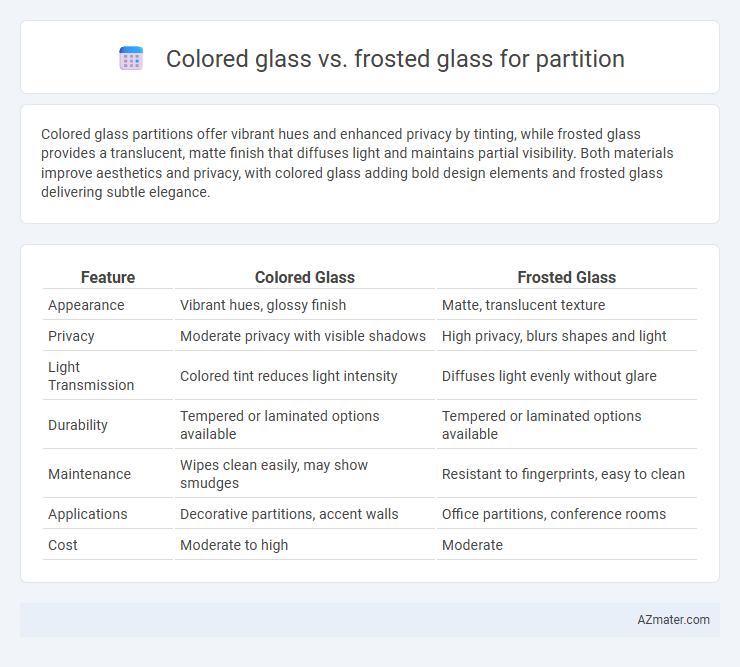Colored glass partitions offer vibrant hues and enhanced privacy by tinting, while frosted glass provides a translucent, matte finish that diffuses light and maintains partial visibility. Both materials improve aesthetics and privacy, with colored glass adding bold design elements and frosted glass delivering subtle elegance.
Table of Comparison
| Feature | Colored Glass | Frosted Glass |
|---|---|---|
| Appearance | Vibrant hues, glossy finish | Matte, translucent texture |
| Privacy | Moderate privacy with visible shadows | High privacy, blurs shapes and light |
| Light Transmission | Colored tint reduces light intensity | Diffuses light evenly without glare |
| Durability | Tempered or laminated options available | Tempered or laminated options available |
| Maintenance | Wipes clean easily, may show smudges | Resistant to fingerprints, easy to clean |
| Applications | Decorative partitions, accent walls | Office partitions, conference rooms |
| Cost | Moderate to high | Moderate |
Introduction to Glass Partitions
Glass partitions enhance interior spaces by maximizing natural light while providing defined areas. Colored glass offers vibrant hues and modern aesthetics, ideal for creating bold visual statements and privacy through tinting. Frosted glass delivers a subtle, translucent effect that balances privacy with light diffusion, making it suitable for professional and minimalist environments.
Understanding Colored Glass Partitions
Colored glass partitions enhance interior spaces by adding vibrant hues that can define zones while allowing light transmission. They are available in various tints and finishes, offering customization for privacy levels and aesthetic appeal. Compared to frosted glass, colored glass provides stronger visual impact without compromising translucency, making it ideal for creative office or commercial environments.
Exploring Frosted Glass Partitions
Frosted glass partitions offer privacy without sacrificing natural light, creating a balanced workspace environment that enhances focus and aesthetics. Unlike colored glass that can alter color perception and mood, frosted glass provides a neutral, elegant appearance that blends seamlessly with various interior designs. Its semi-opaque finish reduces glare and ensures discretion, making it ideal for offices, conference rooms, and residential spaces seeking both functionality and style.
Aesthetic Appeal: Colored vs Frosted Glass
Colored glass partitions create a bold and vibrant aesthetic, adding a striking visual element that can complement modern or eclectic interior designs. Frosted glass offers a softer, more subtle appearance, providing privacy while maintaining light diffusion and an elegant, minimalist look. For aesthetic appeal, colored glass emphasizes color intensity and personality, whereas frosted glass highlights texture and understated sophistication.
Privacy Comparison: Which Glass Offers More?
Frosted glass provides greater privacy for partitions by diffusing light and obscuring shapes, preventing clear visibility through the pane. Colored glass, while offering aesthetic appeal and some light filtering, remains more transparent and thus allows more visibility compared to frosted glass. For environments prioritizing confidentiality, frosted glass is the superior choice to ensure enhanced privacy.
Light Transmission Differences
Colored glass reduces light transmission by filtering specific wavelengths, creating a tinted effect that limits brightness and alters the color spectrum passing through. Frosted glass diffuses light evenly, maintaining high light transmission while obscuring visibility and providing privacy. For partitions, choosing colored glass offers vibrant aesthetic contrasts with moderate light reduction, whereas frosted glass ensures a softer, more uniform illumination with maximum privacy.
Durability and Maintenance Considerations
Colored glass partitions offer high durability due to their tempered or laminated construction, making them resistant to scratches and impact, while requiring minimal maintenance with regular cleaning using non-abrasive solutions. Frosted glass, often created by sandblasting or acid etching, provides moderate durability but can be more susceptible to surface wear and permanent stains from harsh cleaners, necessitating careful maintenance practices to preserve its matte appearance. Choosing between colored and frosted glass depends on the environment's exposure to wear and the desired balance between aesthetic appeal and upkeep effort.
Cost Analysis: Colored vs Frosted Glass
Colored glass for partitions typically incurs higher costs due to specialized manufacturing processes and pigment integration, whereas frosted glass is generally more affordable, achieved through sandblasting or acid etching techniques. Installation expenses can vary, with colored glass requiring cautious handling to preserve its finish, potentially increasing labor costs compared to frosted glass. Long-term maintenance and durability of colored glass may offset initial expenses, but frosted glass remains a cost-effective choice for budget-conscious partition solutions.
Best Applications for Colored Glass Partitions
Colored glass partitions are ideal for creative office spaces, retail environments, and hospitality settings where vibrant aesthetics and brand identity play a crucial role. Their ability to enhance natural light while providing partial privacy makes them perfect for conference rooms, feature walls, and decorative partitions. Colored glass also offers durability and ease of maintenance, making it suitable for high-traffic areas requiring both style and functionality.
Ideal Uses for Frosted Glass Partitions
Frosted glass partitions are ideal for office environments requiring privacy while maintaining natural light flow, such as conference rooms, meeting areas, and private workspaces. Their translucent surface diffuses light and obscures silhouettes, enhancing confidentiality without sacrificing openness. This makes frosted glass a preferred choice for spaces that demand visual separation alongside an airy, modern aesthetic.

Infographic: Colored glass vs Frosted glass for Partition
 azmater.com
azmater.com